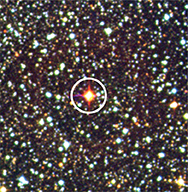26.2 Stars
Reading Focus
Key Concepts
 How can the distance to a star be measured?
How can the distance to a star be measured? How do astronomers categorize stars?
How do astronomers categorize stars? What elements are found in stars?
What elements are found in stars? How do astronomers use H-R diagram?
How do astronomers use H-R diagram?
Vocabulary
star
light-year
parallax
apparent brightness
absolute brightness
absorption lines
H-R diagram
main sequence
supergiants
giants
white dwarf
Reading Strategy
Using Prior Knowledge Copy the concept map below. Add what you already know about stars. After you read, complete your concept map, adding more ovals as needed.

Figure 8 Proxima Centauri, the red star at the center, is the closest star to the sun.

If you look up at the sky at night, you'll see that stars look like points of light. You will probably also notice that some stars are brighter than others. If you look closely, you'll see that some stars have different colors, as shown in Figure 8. However, you can't tell how large or how far away a star is simply by looking at it. You can't poke a star, crawl around inside it, or take its temperature with a thermometer. To explore the stars, modern astronomers use spectrographs and other instruments mounted on telescopes.
A star is a large, glowing ball of gas in space, which generates energy through nuclear fusion in its core. The closest star to Earth is the sun, which is considered to be a fairly average star.
Distances to the Stars
Although the sky seems full of stars, most of the universe is nearly empty space. This seeming contradiction exists because most stars are separated by vast distances.
The Light-Year
You wouldn't measure the distance between two distant cities in centimeters. Similarly, because stars are so far apart, it's not practical to measure their distances in units that might be used on Earth, such as kilometers. Instead, astronomers use much larger units, including the light-year. A light-year is the distance that light travels in a vacuum in a year, which is about 9.5 trillion kilometers. Proxima Centauri, the closest star to the sun, is about 4.3 light-years away.




